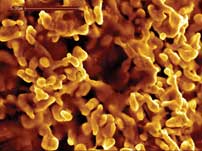|
News Notes
Geomicrobiology
Microbes act as alchemists
 According to Greek myth, King Midas’ gift for touching objects and turning them to gold proved to be a curse. For one microbe, however, a similar ability might be a lifesaver.
According to Greek myth, King Midas’ gift for touching objects and turning them to gold proved to be a curse. For one microbe, however, a similar ability might be a lifesaver.
A scanning electron microscope image reveals gold structures precipitated by bacteria. The ability to turn a toxic solution into gold might help the bacteria survive. Image is courtesy of Frank Reith.
Placed in a solution of toxic gold and chloride, Ralstonia metallidurans can take elemental gold and transform it into a nontoxic solid clump of gold — a trick that might help the microbe survive in seemingly inhospitable environments, says Frank Reith, a geomicrobiologist at the Cooperative Research Centre for Land-scape Environments and Mineral Exploration in Western Australia, and colleagues. The finding adds fodder to scientists’ debate about whether small gold grains grow by chemical or microbial processes, or a combination of both (see Geotimes, April 2006).
In the lab, microbiologists have studied similar gold-accumulating microbes since the 1970s. That work showed that indeed, bacteria can precipitate solid gold out of a solution. And in the field, geomicrobiologists have previously noticed microscopic structures on gold grains that looked like organisms. But, “the link between these two lines of research was not really established,” Reith says.
Looking to find that link, Reith and colleagues headed to two Australian mines and collected gold grains emblazoned with the enigmatic biologic structures. Staining and microscopy techniques on the grains turned up thin layers of microorganisms. But the real test came when the team extracted the organisms’ DNA to find out “who’s actually there,” Reith says.
As reported in the July 14 Science, the battery of DNA tests turned up 30 different bacteria species, including R. metallidurans. Previous lab research has shown that the organism can live in an area of high metal contamination, such as silver, cadmium and chromium, and can precipitate these metals, but no one had ever looked into R. metallidurans and gold, Reith says. If the same microbe discovered on gold grains in the field also precipitated metallic gold grains in the lab, it would imply that microbes likely contribute to the deposition of some gold in nature, the researchers wrote.
After the team subjected R. metallidurans to a gold chloride solution, about 90 percent of the organisms initially died as the toxic solution ripped the cells apart, Reith says. By some yet-unknown mechanism, however, some adapted and survived by converting the gold in the solution into metallic gold.
The research “goes a long way to highlighting a role for bacteria in the formation of gold nuggets,” says Gordon Southam, a geomicrobiologist at the University of Western Ontario in Canada. The experiment, however, “suffers” from the limitation that “chloride complexes are considered to be rare in surface environments,” he says.
Addressing that issue will be the next step, Reith says. The team will try to produce gold grains “in more in-situ-like environments,” in sand and soils.
Reith says that his team’s research does not imply that microbial processes are the only way gold accumulates. “Weathering and chemical accretion are still valid processes,” he explains.
Perhaps the “most significant aspect” of the research, Southam says, are the implications for exploration. Drilling down about 100 meters in Australia to look for signs of gold can be expensive, so mining companies are looking at other ways to establish at the surface where gold mineralization likely takes place. “One way,” he says, “could be to look at microorganisms that are associated with gold.”
Kathryn Hansen
Links:
"The Rush to Uncover Gold’s Origins," Geotimes, April 2006

 Subscribe
Subscribe

